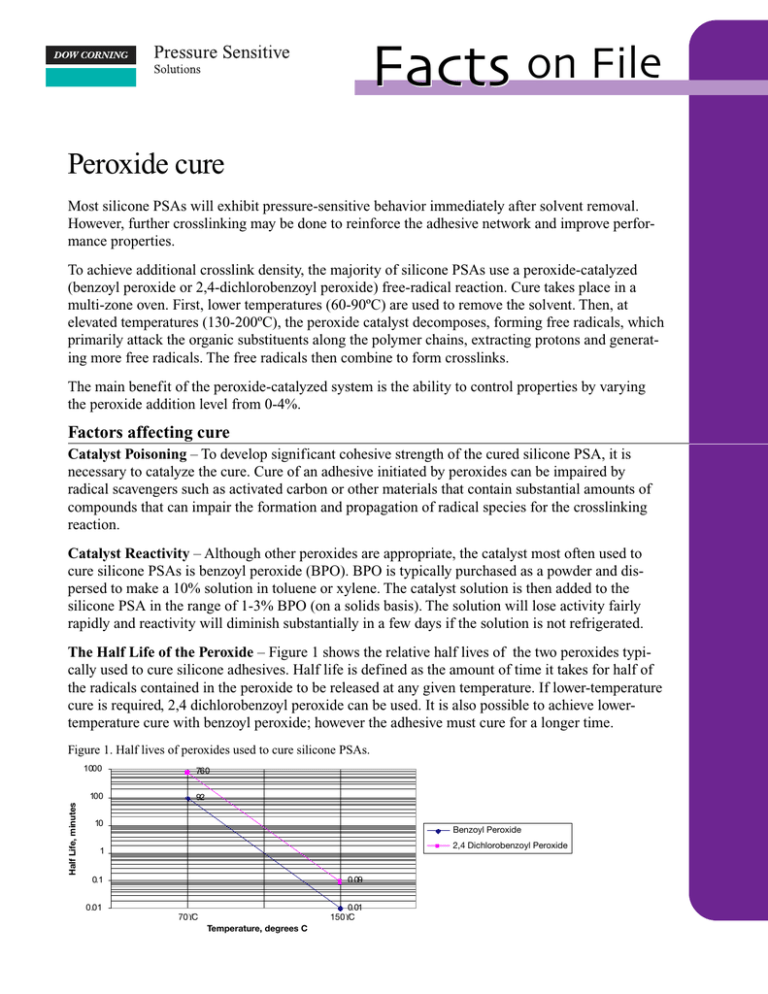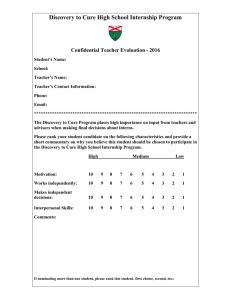
Facts on File
Peroxide cure
Most silicone PSAs will exhibit pressure-sensitive behavior immediately after solvent removal.
However, further crosslinking may be done to reinforce the adhesive network and improve performance properties.
To achieve additional crosslink density, the majority of silicone PSAs use a peroxide-catalyzed
(benzoyl peroxide or 2,4-dichlorobenzoyl peroxide) free-radical reaction. Cure takes place in a
multi-zone oven. First, lower temperatures (60-90ºC) are used to remove the solvent. Then, at
elevated temperatures (130-200ºC), the peroxide catalyst decomposes, forming free radicals, which
primarily attack the organic substituents along the polymer chains, extracting protons and generating more free radicals. The free radicals then combine to form crosslinks.
The main benefit of the peroxide-catalyzed system is the ability to control properties by varying
the peroxide addition level from 0-4%.
Factors affecting cure
Catalyst Poisoning – To develop significant cohesive strength of the cured silicone PSA, it is
necessary to catalyze the cure. Cure of an adhesive initiated by peroxides can be impaired by
radical scavengers such as activated carbon or other materials that contain substantial amounts of
compounds that can impair the formation and propagation of radical species for the crosslinking
reaction.
Catalyst Reactivity – Although other peroxides are appropriate, the catalyst most often used to
cure silicone PSAs is benzoyl peroxide (BPO). BPO is typically purchased as a powder and dispersed to make a 10% solution in toluene or xylene. The catalyst solution is then added to the
silicone PSA in the range of 1-3% BPO (on a solids basis). The solution will lose activity fairly
rapidly and reactivity will diminish substantially in a few days if the solution is not refrigerated.
The Half Life of the Peroxide – Figure 1 shows the relative half lives of the two peroxides typically used to cure silicone adhesives. Half life is defined as the amount of time it takes for half of
the radicals contained in the peroxide to be released at any given temperature. If lower-temperature
cure is required, 2,4 dichlorobenzoyl peroxide can be used. It is also possible to achieve lowertemperature cure with benzoyl peroxide; however the adhesive must cure for a longer time.
Figure 1. Half lives of peroxides used to cure silicone PSAs.
1000
Half Life, minutes
100
760
92
10
Benxoyl
de
BenzoylPeroxi
Peroxide
2,4
Peroxide
2,4Dichlorobenzoyl
Dichlorobenzoyl
Peroxide
1
0.1
0.01
0.09
0.01
150
C
150°C
70
C
70°C
Temperature, degrees C
Time and Temperature – Cure is measured by the extractable silicone portion of the adhesive,
which levels off (indicating complete cure) at about 50%. Cure may be achieved at lower temperatures – an advantage when using temperature-sensitive substrates. However, optimum cure is
achieved much more quickly at higher temperatures. (See Figure 2.)
Figure 2. Effect of time and temperature on cure of a peroxide-cured silicone PSA.
70
Cure,%
% gels
gels
Cure,
60
50
70…
C / 132…
C
70°C/132°C
40
70…
C / 150…
C
70°C/150°C
30
70…
C / 178…
C
70°C/178°C
20
10
0
0
1
2
3
4
5
6
Tim e, m
inutes
Time,
minutes
Factors affecting adhesion to the substrate
Peroxide Level – Initially, increasing the peroxide level will increase adhesion due to greater
crosslinking of the adhesive. However, further increases in peroxide level will decrease adhesion.
Tack also decreases as the peroxide level is increased and the adhesive becomes harder. (See
Figure 3.)
Figure 3. Effect of peroxide level on adhesive properties.
35
35
1050
1050
1000
1000
950
950
900
900
25
25
850
850
800
800
20
20
750
750
700
700
15
15
650
650
10
10
600
600
11
22
33
Benzoyl Peroxide, %
55
Tack, g
Adhesion, oz/in
30
30
Adhesion
Adhesion
Tack
Tack
Cure Time and Temperature – The higher the temperature, the more quickly optimum adhesion is
achieved. (See Figure 4.)
Figure 4. Effect of time and temperature on adhesion of a peroxide-cured silicone PSA.
70
Adhesion,
oz/in
Adhesion,
oz/in
60
50
40
150…
C
150°C
200…
C
200°C
30
20
10
0
1
2
3
4
5
6
7
8
9
10
CureTime,
Time,minutes
minutes
Cure
For PSA troubleshooting assistance
Contact your Dow Corning technical representative or email psi@dowcorning.com.
For pressure sensitive product and service information
Visit www.dowcorning.com/psi. For easy future reference, bookmark the page and add it to your
list of “Favorites.”
We’re here to help
Whether you are trying to solve a problem, improve your profits or take advantage of a new opportunity, the Dow Corning team can help … with solutions, capabilities and choices you may never
have imagined.
Dow Corning is more than materials and more than silicones. We are also process optimizers, cost
reducers, custom formulators, applications engineers, technology innovators, productivity experts,
global market expanders and more.
Let us put our innovative thinking to work for you.
Dow Corning is a registered trademark of Dow Corning Corporation.
We help you invent the future is a trademark of Dow Corning Corporation.
©2004 Dow Corning Corporation. All rights reserved.
Printed in USA
AGP6909
Form No. 30-1090-01




